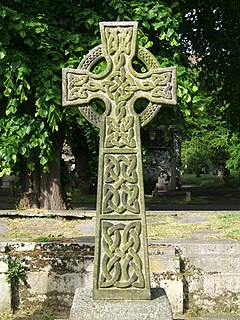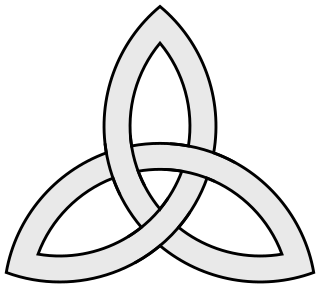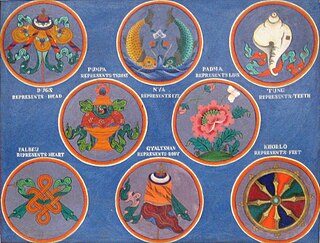
In Greek mythology, the Labyrinth was an elaborate, confusing structure designed and built by the legendary artificer Daedalus for King Minos of Crete at Knossos. Its function was to hold the Minotaur, the monster eventually killed by the hero Theseus. Daedalus had so cunningly made the Labyrinth that he could barely escape it after he built it.

Trefoil is a graphic form composed of the outline of three overlapping rings used in architecture and Christian symbolism. The term is also applied to other symbols of three-fold shape. A similar shape with four rings is called a quatrefoil.

Celtic knots are a variety of knots and stylized graphical representations of knots used for decoration, used extensively in the Celtic style of Insular art. These knots are most known for their adaptation for use in the ornamentation of Christian monuments and manuscripts, such as the 8th-century St. Teilo Gospels, the Book of Kells and the Lindisfarne Gospels. Most are endless knots, and many are varieties of basket weave knots.

A high cross or standing cross is a free-standing Christian cross made of stone and often richly decorated. There was a unique Early Medieval tradition in Ireland and Britain of raising large sculpted stone crosses, usually outdoors. These probably developed from earlier traditions using wood, perhaps with metalwork attachments, and earlier pagan Celtic memorial stones; the Pictish stones of Scotland may also have influenced the form. The earliest surviving examples seem to come from the territory of the Anglo-Saxon kingdom of Northumbria, which had been converted to Christianity by Irish missionaries; it remains unclear whether the form first developed in Ireland or Britain.

In topology, knot theory is the study of mathematical knots. While inspired by knots which appear in daily life, such as those in shoelaces and rope, a mathematical knot differs in that the ends are joined together so that it cannot be undone, the simplest knot being a ring. In mathematical language, a knot is an embedding of a circle in 3-dimensional Euclidean space, R3. Two mathematical knots are equivalent if one can be transformed into the other via a deformation of R3 upon itself ; these transformations correspond to manipulations of a knotted string that do not involve cutting the string or passing the string through itself.
A pentacle is a talisman that is used in magical evocation, and is usually made of parchment, paper, cloth, or metal, upon which a magical design is drawn. Protective symbols may also be included, a common one being the six-point form of the Seal of Solomon.

A hexagram (Greek) or sexagram (Latin) is a six-pointed geometric star figure with the Schläfli symbol {6/2}, 2{3}, or {{3}}. Since there are no true regular continuous hexagrams, the term is instead used to refer to the compound figure of two equilateral triangles shown to the right. The intersection is a regular hexagon.

The Celtic cross is a form of Christian cross featuring a nimbus or ring that emerged in Ireland, France and Britain in the Early Middle Ages. A type of ringed cross, it became widespread through its use in the stone high crosses erected across the islands, especially in regions evangelized by Irish missionaries, from the 9th through the 12th centuries.

In knot theory, a branch of mathematics, the trefoil knot is the simplest example of a nontrivial knot. The trefoil can be obtained by joining together the two loose ends of a common overhand knot, resulting in a knotted loop. As the simplest knot, the trefoil is fundamental to the study of mathematical knot theory.

The valknut is a symbol consisting of three interlocked triangles. It appears on a variety of objects from the archaeological record of the ancient Germanic peoples. The term valknut is derived from the modern era and the term or terms used to referred to the symbol during its historical employment is unknown.

The endless knot or eternal knot is a symbolic knot and one of the Eight Auspicious Symbols. It is an important symbol in both Jainism and Buddhism. It is an important cultural marker in places significantly influenced by Tibetan Buddhism such as Tibet, Mongolia, Tuva, Kalmykia, and Buryatia. It is also found in Celtic and Chinese symbolism.

The triquetra is a triangular figure composed of three interlaced arcs, or (equivalently) three overlapping vesicae piscis lens shapes.

The Ashtamangala is a sacred suite of Eight Auspicious Signs endemic to a number of religions such as Hinduism, Jainism, and Buddhism. The symbols or "symbolic attributes" are yidam and teaching tools. Not only do these attributes point to qualities of enlightened mindstream, but they are the investiture that ornaments these enlightened "qualities". Many cultural enumerations and variations of the Ashtamangala are extant.

Celtic art is associated with the peoples known as Celts; those who spoke the Celtic languages in Europe from pre-history through to the modern period, as well as the art of ancient peoples whose language is uncertain, but have cultural and stylistic similarities with speakers of Celtic languages.
Star polygons and polygonal compounds are the basis for numerous figures of significance in arts and culture. The figure may be the border or interior of the polygon, or one or more closed polygonal paths that include all of the border and also have some legs crossing the interior. Impressions of astronomical stars provide the term, but specific uses may exploit the connection or not. Stars often represent the unity of states within a country when they are used as a part of the flag.

The unicursal hexagram is a hexagram or six-pointed star that can be traced or drawn unicursally, in one continuous line rather than by two overlaid triangles. The hexagram can also be depicted inside a circle with the points touching it. It is often depicted in an interlaced form with the lines of the hexagram passing over and under one another to form a knot. It is a specific instance of the far more general shape discussed in Blaise Pascal's 1639 Hexagrammum Mysticum Theorem.

Interlacing patterns are patterns of lines and shapes that have traditionally dominated Islamic art. They can be broadly divided into the arabesque, using curving plant-based elements, and the girih, using mostly geometrical forms with straight lines or regular curves. Both of these forms of Islamic art developed from the rich interlacing patterns of the Byzantine Empire and from Coptic art.

Solomon's knot is a traditional decorative motif used since ancient times, and found in many cultures. Despite the name, it is classified as a link, and is not a true knot according to the definitions of mathematical knot theory.

In the visual arts, interlace is a decorative element found in medieval art. In interlace, bands or portions of other motifs are looped, braided, and knotted in complex geometric patterns, often to fill a space. Interlacing is common in the Migration period art of Northern Europe, especially in the Insular art of Ireland and the British Isles and Norse art of the Early Middle Ages and in Islamic art.




















